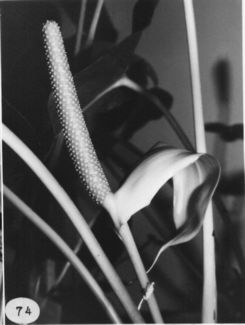





TYPE: Panama. Darien: Serrania de Pirre, ca. 12 km due N of Alturas de Nique, 1,520-1,560 m, Croat 37901 (MO 2416624, ho-lotype; K, NY, PMA, SEL, US, VEN, isotypes; Live at MO).
Planta tenestris aut epiphytica; caudex elongatus, cataphyllum subcoriaceum, persistens intactum; petiolus teres aut obscure sulcatus, 19-62 cm longus; lamina subcoriacea, ovata ad ovata-triangulata, basi pro-funde cordata, 18-50 cm longa, 12-28 cm lata; inflorescentia erecta ad effusa; pedunculus teres, (8-) 14-40 cm longus; spatha coriacea, pallide viridis, lanceolata, 5.5-16 cm longa; spadix roseus, pallide lavandulescens, 3.5-9 cm longus; baccae apice rubro-violaceae, basi albescentes.
Terrestrial or epiphytic; stems elongate, 10 cm or more long, 1.5-2 cm diam.; internodes to 1.5 cm long; closer near the apex; roots several at each node, gray-green to brown; cataphylls subcoriaceous, 12-17 cm long, acute at apex with minute subapical apiculum, drying brown (B & K Yellow 5/2.5), persisting intact at upper nodes, deciduous at lower nodes.
LEAVES with petioles spreading, 19-62 cm long, terete to obscurely sulcate; geniculum 2-4 cm long; blades ovate to ovate-triangular, subcoriaceous, gradually long-acuminate to abruptly long-acuminate at apex (the acumen flat), broadly to deeply lobed at base, 18-50 cm long, 12-28 cm wide, broadest al base or at point of petiole attachment; anterior lobe 12-39 cm long, the margins broadly rounded; posterior lobes 5-16 cm from apex of sinus to outermost point; the sinus parabolic to hippocrepiform, rounded at apex; upper surface matte to semiglossy with conspicuous raphide cells, lower surface semiglossy; midrib raised above, diminishing and flat toward apex, convexly raised below; basal veins 4÷7 pairs, the first and second free to base, the remaining coalesced to 3 cm, flat to sunken above, raised below, the posterior rib turned up weakly along the outer margin; primary lateral veins 4÷6 per side, departing midrib at 35-45ˇ angle, weakly arching to collective vein, sunken above, raised below; interprimary and secondary veins sunken above, more or less obscure below; collective vein arising from the first basal vein, loop-connecting the primary lateral veins, 5-10 mm from margin.
INFLORESCENCE erect to spreading; peduncle (8-)14÷40 cm long, 2-4 mm diam., terete, one-third to two-thirds as long as petiole; spathe subcoriaceous, light green (B & K Yellow-green 9/ 5-7/10), lanceolate, 5.5-16 cm long, 2-4.5 cm wide, broadest at base, caudate-acuminate at apex (acumen inrolled, to 3.5 cm long) obtuse to rounded at base, inserted at 30ˇ angle on peduncle; stipe 1-3 mm long; spadix pink (B & K Red 8/5 to Red-purple 6/2.5), fading to a pale lavender (B & K. Purple 7/5), scarcely tapered toward apex, 3.5-9 cm long, 5-10 mm diam. at base, 4-6 mm diam. at apex, sweet, minty scented at anthesis; flowers 4-lobed, 2.7-3.3 mm in both directions, the sides jaggedly sigmoid, 5-8 flowers visible in the principal spiral, 7-12 flowers visible in the alternate spiral; tepals glossy, smooth, lateral tepals 1-1.5 mm wide, the inner margin convex, the outer margin irregularly 4-sided; pistils weakly raised before emerging, white, glossy; stigmas linear 0.2-0.4 mm long, exserted, brush-like, drying brown before stamens emerge; stamens emerging in scattered manner, laterals first, followed quickly by alternates; anthers white, ca. 0.5 mm in both directions, held in a contiguous cluster over pistil; thecae ellipsoid, slightly divaricate; pollen white.
INFRUCTESCENCE with acute violet purple berries, 9-9.5 mm long, 3.7-4 mm diam., elliptic; mesocarp syrupy with elongate raphide cells; seeds 1 (?), yellow, ca. 3.5 mm long, 2.5 mm wide. Figs. 73 and 74.
Anthurium erythrostachyum is known from Panama in Darien Province and in Colombia in the Choco region. It is found at elevations of 1,100 to 1,560 m in premontane rain and lower montane rain forest life zones.
The species is a member of section Calomystrium and can be recognized by its elongate stem with persisting, brown cataphylls, its ovate-triangular blade with conspicuous raphide cells on the upper surface, its pinkish spadix with glossy tepals and white, exserted pistils and by its pale green, caudate-acuminate spathe. The species is not easily confused with any other member of section Calomystrium. It might be confused with Anthurium roseospadix, an endemic species that has a similarly colored spadix, but the latter is distinguished by having smaller, thicker leaves, a usually shorter, stouter stem, and a usually whitish spathe more abruptly acuminate with a relatively short acumen.
 |
 |
Map of Mesoamerican specimens with coordinates
PanamaDarien: Parque Nacional del DariŽn, 1250-1500 m, 8.04.30N 77.14.00W, 20-26 Oct. 1987, Greg de Nevers, H. Cuadros, B. Hammel & H. Herrera 8473 (CAS, MO).
Darien: vicinity Alturas de Nique, Croat 37901 (K., MO, NY, PMA, SEL, US, VEN), 37879 (MO), Gentry et al. 28646 (COL, F, MO, PMA), Hartman 12410 (MO);
Serrania de Pirre between Río Cana & Río Escucha Ruido, Croat 37826 (F, MO, PMA, NY); Cerro Pirre, Folsom 4293, 4348, 4479 (MO), Folsom et al. 6303 (MO, PMA), Folsom & Mauseth 8544 (MO).